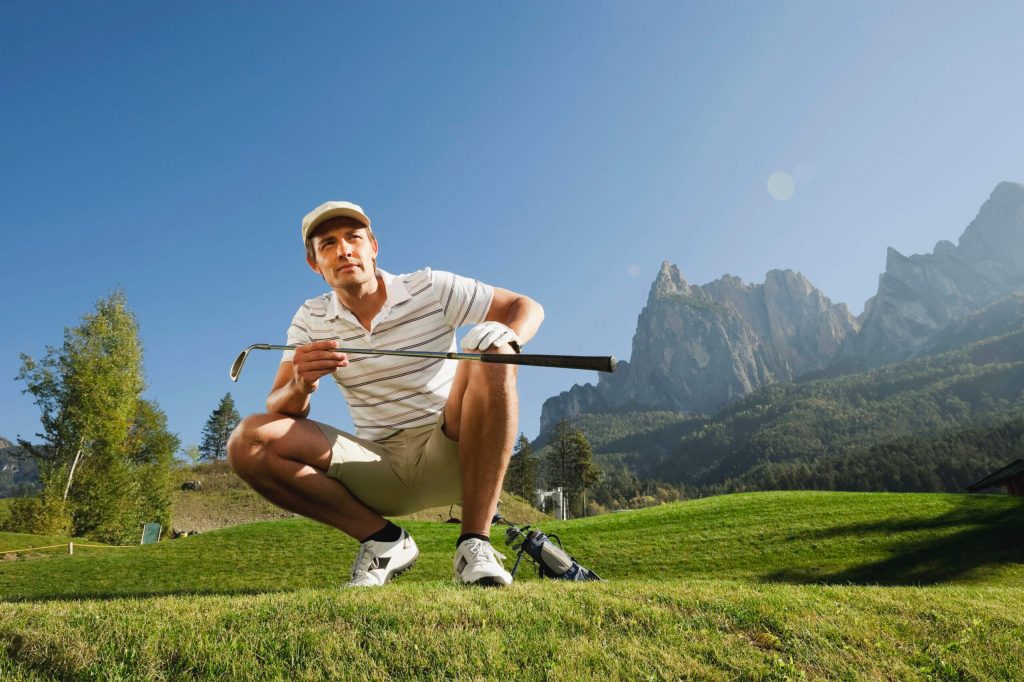Although golf can seem like a low energy output sport, it still requires the same precautions and preparations as all other sports. In golfing, you use your entire body in an athletic stance to precisely aim that golf ball. So it is important to know how to prevent injury or pain before playing golf.
Your knees are used significantly during golfing as you use them as an anchor for pivoting your hips during your swing. Over time, your knees may get tired from the constant bending and the pressure golfing puts on them. Remember to stretch and properly hydrate to prevent tightness and unnecessary soreness prior to hitting the course. This can help with preventing future injury or discomfort.
If you consistently have pain during or after a round of golf, it could be an indication of more serious injuries or possible problems in your golf game. Check with your doctor or a physical therapist to identify if you could be experiencing more serious issues. However, many people experience discomfort every now and again from not doing proper preparation before their game. This is why it is so important to know how to prepare and also how to treat any golf-related knee pain you experience.
4 treatments that can help ease golf-related knee pain
- Try the RICE method.
This method is often recommended for any pain in the body. It is frequently taught in first aid and can be used at home. RICE is an acronym for rest, ice, compression and elevate. You can either sit or lie down in a comfortable area to use this method. Ice can help ease your inflammation and swelling. Then compression (e.g., using an elastic bandage) can help improve blood flow. Please note that you should always be able to stick two fingers underneath the fabric when using compression on an injury. Otherwise, the bandage is likely too tight and can restrict blood flow. Finally, elevate means to keep the knee above the heart, which can help decrease inflammation.
- Use knee braces.
Your knees are central to golfing, and you may be overworking them by golfing for extended periods of time. Wearing knee braces may help provide additional support during your golf game. Knee braces can also help give extra stability to your knees as you apply pressure to them.
- Do stretching and warmup swings.
Warming up before playing golf is crucial to a safe and effective game. It can help your muscles not become shocked from jumping right into movement. Stretching and gentle warmup movements are great right before a workout to ensure that your body is ready to golf. Stretches can also help ease any knee discomfort you feel after golfing due to tight, tired muscles. Another way to reduce the risk of knee pain is to do some short warmup swings before your round and then slowly go to a full swing. Doing so lets your body become more warm and loose before you start your actual game.
- Do strength training in addition to playing golf.
Tailored strength training can help you build stability and mobility that can help you during your golf game. Building muscle and stability through weighted or calisthenic exercises can also help protect you from injuries and accidents while golfing.
3 tips that can help reduce golf-related knee pain
While the treatments above may be helpful for easing your knee pain, there are some tips that may help, too. Some of these tips are:
- Wear golf shoes with arch supports.
Without proper arch support, you’re tensing the muscles in your legs and feet for extended periods of time as you golf. This can cause pain and soreness in your knee and other parts of your leg. Wearing golf shoes with arch support (or adding arch supports to your golf shoes) can help reduce overall pain and tenseness throughout your legs. Arch support can help align muscles and tendons that attach to the knee. Golf shoes with arch support also better fit the natural shape of your feet and can help your muscles relax and tense more naturally as you move. These shoes can give you better confidence and comfort during a round of golf. They can even help reduce or prevent knee pain.
- Switch to lighter golf clubs.
Yet another way to reduce your knee pain is to try practicing or playing with lighter golf clubs. Lighter clubs can help improve the form of your swing. Using them can also allow you to put less force into your swing and get similar results. Both of these factors can reduce the stress on your knees as you swing.
- Ease up on how much you golf.
Knee pain after a round of golf or golfing practice may mean you’re doing too much in your sessions. If that’s the case, you may simply need to cut back on how much you’re playing or practicing for a while. Cutting back will allow your body more time to recover, which can lead to less pain. It’s also a good idea to seek professional help, such as physical therapy, if your knee pain has been around for a while.
Tried these techniques and golfing still causes you knee pain? Rehab Access can help
If you notice that your knee pain persists even after trying these tips and treatments, you should consider seeking physical therapy. At Rehab Access Physical Therapy, our physical therapists are here to help you understand the roots of your knee pain. Knee pain from playing golf can be an indicator of a more serious underlying issue and can cause long-term issues if left untreated. Our specialists are committed to helping golfers:
- Discover and learn about the root cause of their knee pain.
- Develop a personalized treatment plan to reduce their knee pain.
- Learn techniques to reduce the risk of future knee pain.
Ready to start getting our help with your knee pain? Contact our team today for more information about our treatment options or to schedule your first PT session.

